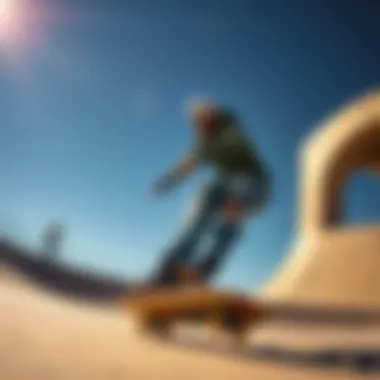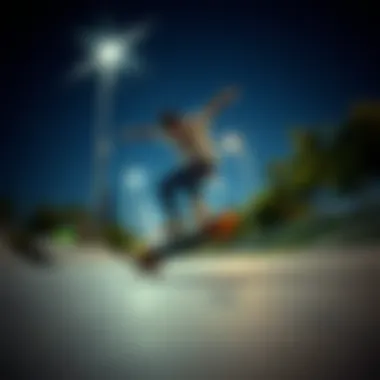The Intricacies of Skateboarding: A Comprehensive Guide


Intro
Skateboarding is more than just a means of transportation; it’s a subculture that weaves through the fabric of society, influencing art, music, and lifestyle. Many see it as a pastime associated with youth, but for countless enthusiasts and professionals, it embodies a lifelong commitment to skill and creativity. In this exploration of skateboarding, we’re diving into various elements that make this sport accessible, engaging, and profoundly influential. Whether you’re new to skating, an experienced rider, or someone in the industry, this guide will shed light on critical techniques, cultural importance, essential gear, and the rollercoaster of learning that all skaters experience.
As we go through the nuances of skateboard tricks and maneuvers, you will also get a look at the various types of skateboards available on the market today. The importance of the right equipment can’t be overstated; it’s often the difference between just rolling on a board and experiencing true freedom on the pavement. Additionally, we’ll discuss protective gear, providing recommendations to ensure your safety as you push your limits.
In a landscape where trends come and go, skateboarding remains timeless, constantly evolving yet rooted in rich history. This article aims to serve both the novice and the seasoned pro, presenting a deep understanding of the sport. Let's roll right into the techniques that define the art of skateboarding!
Prologue to Skateboarding Culture
Skateboarding culture is a unique blend of art, sport, and a way of life that has evolved over decades. Understanding this culture is crucial for anyone who wishes to grasp what skateboarding embodies beyond just the physical sport. It represents freedom, creativity, and a community where individuals express themselves through movement and style. Most importantly, skateboarding is more than tricks on a board; it’s about the connections formed and the identities created in skate parks, streets, and during competitions.
The layers of this culture encompass the evolution of skateboarding, the historical milestones that shape the present landscape, and the figures who have become icons and role models in the community.
Evolving History of Skateboarding
From its humble beginnings in the late 1940s and early 1950s, skateboarding has undergone a significant transformation. Initially a pastime for surfers looking to replicate the thrill of riding waves, it quickly gained traction among youth seeking adventure and thrill, turning streets into playgrounds. The first skateboards were basic wooden planks with wheels from roller skates, a far cry from the advanced technology we see today.
By the 1970s, skateboarding entered the mainstream, fueled by the emergence of skate parks and the pioneering spirit of skaters like Tony Hawk and Stacy Peralta. The introduction of vert ramps changed the game, propelling skateboarding into the realm of extreme sports. As the sport evolved, so did the community; it became a gathering space where creative expression could flourish without judgment.
Skateboarding’s cultural significance cannot be overstated. Socially, it represents a counterculture that challenges norms, where individuality reigns. It has provided a voice for those marginalized in traditional sports, leading to a rich tapestry of diversity within the skateboarding community. Skateboarding’s influence can also be seen in fashion, music, and art, indicating its role as a significant cultural force. In modern times, skateboarding has found a niche in the Olympic arena, pushing boundaries and introducing it to an even broader audience while simultaneously preserving its renegade spirit.
Key Figures in Skateboarding
Throughout its history, skateboarding has been shaped by numerous influential figures who have laid the groundwork for today’s culture. Notable among these is Tony Hawk, who not only achieved legendary status through his tricks and competitions but also played a pivotal role in bringing mainstream attention to the sport. His impact goes beyond performance; he launched several skateboarding initiatives, inspiring countless aspiring skaters around the globe.
Another key figure is Rodney Mullen, credited with inventing many tricks fundamental to street skating, paving the way for a generation of skaters who view the streets as their canvas. His philosophical contributions to the sport further emphasize skateboarding as an art form. Similarly, women like Elissa Steamer have broken barriers, showing that skateboarding isn’t solely a male-dominated sport; they’ve become vital parts of the community, showing girls that they, too, can rock a skateboard.
These personalities, along with many others, embody the spirit of skateboarding culture. Their stories, tricks, and unique styles foster connections that transcend geographical borders, underscoring the notion that skateboarding is a universal language of movement and creativity.
“Skateboarding is rebellion. It’s about being creative and expressing yourself in your own unique way.” – Unknown
In summary, skateboarding’s culture serves as a rich background to understanding the sport deeply. From its deep-rooted history that mirrors social changes to the diverse cast of characters who contribute to its vibrant landscape, skateboarding has solidified its place as a vital part of many lives. Whether you are a skateboarder or an enthusiast, appreciation of this culture enhances the overall experience many share on their boards.
Core Skateboarding Techniques
Understanding the core techniques of skateboarding is pivotal for anyone looking to master the sport. Whether you’re just starting or aiming to improve your skills, grasping these fundamental techniques provides a sturdy foundation. Many novice skaters often underestimate the significance of the basic tricks, thinking they can leap into the advanced maneuvers right away. However, mastering the basics not only builds confidence but also cultivates balance, agility, and control, all of which are vital for higher-level skating.
Fundamental Tricks for Beginners
Starting with the basics is like laying the first bricks of a house; without a solid base, everything else crumbles. Beginner tricks such as the ollie, kickflip, and heelflip are essential. The ollie is often regarded as the cornerstone trick in skateboarding, enabling skaters to leap over obstacles and transition into more complex moves smoothly.
Key Tricks:
- Ollie: This pushes the board down while leaping, allowing the rider to lift the board into the air.
- Kickflip: Building on the ollie, the kickflip involves a flick of the front foot to spin the board mid-air.
- Heelflip: Similar to the kickflip, but this time the flick is done with the heel instead of the toes.
Executing these tricks not only helps in establishing a basic skill set but also boosts a skater's confidence. The ability to land these successfully opens up a universe of possibilities in skateboarding.
Progressing to Advanced Maneuvers


Once the foundational tricks are in place, it's time to step up. Progressing to advanced maneuvers requires both practice and a strong understanding of balance and control. Tricks such as the frontside board slide or the 360 flip introduce complexities that can seem daunting at first, but they're absolutely achievable with the right mindset.
As skaters advance, they should focus on:
- Consistency: Landing tricks consistently before attempting more complicated ones.
- Variation: Experimenting with variations of tricks to enhance style and creativity on the board.
- Incorporation of Environment: Learning how to adapt tricks to different environments, like ramps and rails, is crucial for growth.
It's like the rite of passage in skateboarding—once confidence blooms in executing these advanced techniques, skaters often flourish in both capability and creativity.
Common Mistakes and How to Avoid Them
Even experienced skaters can stumble; it’s all part of the learning journey. Recognizing and avoiding common pitfalls can significantly enhance progress. One typical mistake is neglecting safety gear. Many skaters think they’re invincible, but even a small fall can lead to injuries that sideline a skater for weeks.
Other common errors include:
- Improper Stance: Not focusing on foot placement can lead to failed tricks. Proper positioning is critical.
- Ignoring Momentum: Skateboarding requires a certain rhythm. Misjudging speed when attempting a trick can result in wipeouts.
- Too Much Focus on Perfection: It’s easy to get caught up in landing every trick perfectly. Growth happens through trial and error, so embracing mistakes is pivotal.
"Skateboarding is not about being perfect; it’s about progress, pushing boundaries, and finding your unique flow."
To mitigate these mistakes:
- Regular practice and self-analysis can help identify areas needing improvement.
- Setting small, attainable goals fosters a sense of achievement, keeping motivation high.
- Finally, never underestimate the value of community—learn from fellow skaters and share experiences.
In summary, honing core skateboarding techniques demands dedication, but the rewards are immense. From laying down the fundamentals to tackling advanced tricks, each phase of the journey adds to one's skill set, nurtures passion, and fosters an unwavering affinity for the sport.
Skateboarding Gear Essentials
Choosing the right equipment is pivotal in the skateboarding experience. Gear not only impacts performance but also plays a critical role in safety and comfort. The right skateboard becomes almost an extension of the skater, complementing their style and skills. In this section, we’ll look into essential gear that all skaters should consider, diving into the specifics that ensure both enjoyment and safety while riding on those concrete waves.
Choosing the Right Skateboard
Selecting the right skateboard involves understanding different types, styles, and sizes. Not every board suits every skater’s needs, and making the right choice can significantly affect the learning curve and overall experience.
When picking a skateboard, consider the following elements:
- Deck Size: Wider decks offer more stability, whereas narrow decks allow for more tricks and flips. A beginner might prefer something around 7.5 to 8.0 inches wide, while more advanced skaters often opt for narrower boards.
- Material: Generally, skateboards are made from maple wood, with multi-layer construction for strength. However, some brands use bamboo or composite materials for a lighter feel but maintain durability.
- Shape: Skateboards come in various shapes; the classic popsicle shape is versatile, while cruiser shapes are better for mellow rides. Think about where and how you'll be skating.
- Setup Preferences: Some skaters prefer complete boards, while others build their custom setups. A little research can help understand which parts fit best for your riding style.
"The board isn’t just a piece of wood; it’s your identity on wheels. Choose wisely."
Protective Equipment: Importance and Types
Safety should never take a backseat, especially in a sport like skateboarding where falls are common. Protective equipment forms the first line of defense against injuries. Many new riders may overlook this aspect, but it’s essential for both experienced and novice skaters alike.
Here are key protective items to consider:
- Helmets: A quality helmet is non-negotiable. Look for one that meets safety standards and offers a snug fit. A good helmet should not shift during falls.
- Wrist Guards: These are crucial for preventing wrist injuries, which are common when learning to skate. They keep the fragile wrist joints stable during hard falls.
- Knee and Elbow Pads: These pads absorb impacts, allowing the skater to get back up without sustaining severe injuries. It’s worthwhile to choose ones that are comfortable and allow flexibility.
- Shoes: Invest in skate shoes with proper grip and durability. Regular sneakers won't cut it. Brands like Vans or Nike SB are popular for their skate-friendly designs.
Apparel for Skaters: Functionality Meets Style
Skateboarding attire plays a dual role: it reflects individual style while providing functionality. The right clothing allows for flexibility and freedom of movement, which is crucial when shredding.


When choosing apparel, consider:
- Materials: Look for breathable fabrics like cotton or polyester blends that wick moisture away. Loose fits generally work better for unrestricted movement.
- Layers: Depending on the weather, layering can be advantageous. A lightweight, water-resistant jacket is perfect for unexpected rain while still protecting against the cold.
- Skate Pants or Shorts: Look for options that are durable and won’t tear easily during falls. Cargo shorts or stretchable denim can offer both comfort and style.
- Accessories: A comfortable hat can block the sun and keep sweat off your face, while beanies can keep your head warm during colder months.
In summary, selecting the right gear is more than just aesthetics; it's about enhancing performance and protection. Whether you’re just starting or are already rolling with the pros, understanding and investing in the right equipment can elevate your skateboarding experience significantly.
For further reading on skateboarding gear basics, visit Wikipedia Skateboarding or find helpful forums on Reddit Skateboarding Community.
The Community Aspect of Skateboarding
Skateboarding is more than just a physical activity; it's a dynamic, vibrant culture that thrives on community connections. This community aspect plays a crucial role in shaping the experiences of skateboarders at all levels. From local spots to international events, these social networks form a bedrock that supports growth, creativity, and camaraderie among skaters. Embracing this community means recognizing the shared values, struggles, and triumphs that define the skateboard lifestyle.
Skate Parks and Local Spots
Skate parks are the heartbeat of many skateboarding communities. These spaces offer more than just ramps and rails; they serve as gathering spots where skaters can meet, hang out, and practice their skills. Moreover, local skate spots, whether they are uniquely designed parks or plain urban environments, provide an opportunity for skateboarders to express their creativity.
- Accessibility: Locations like local skate parks allow newcomers a place to build confidence, while seasoned skaters can refine their tricks.
- Community Events: Many parks host competitions and “jam” sessions. These events foster a sense of belonging and can often lead to lasting friendships.
- Collective Experience: Skateboarding together in these shared spaces builds unique memories. Every grind, flip, or fall becomes part of a collective narrative that strengthens community ties.
"Skate parks are more than just concrete; they're communities that foster friendships and skill development for all who step on a board."
The Role of Skateboarding Events
Events like competitions, exhibitions, and showcases are vital for bringing skateboarders together under one roof. These occasions not only elevate the sport but also celebrate the culture that surrounds it.
- Visibility: Events help raise the profile of skateboarding and can attract new participants from diverse backgrounds.
- Networking Opportunities: Many industry insiders attend these events, providing opportunities for aspiring professionals to connect. This can lead to sponsorships or mentorships that prove invaluable for growth.
- Unity and Diversity: Skateboarding events often feature skaters of all ages and skill levels, underscoring the inclusive nature of the sport. This melting pot of experiences makes skateboarding richer as a culture.
Building Connections in the Skateboarding World
Connections formed in the skateboarding world can often last a lifetime. These relationships can evolve through shared experiences, collaborations, and even digital communication platforms.
- Online Communities: Social media channels like Facebook groups or forums on Reddit serve as platforms to share tips, tricks, and personal stories. These online interactions often translate into real-life friendships and skate meet-ups.
- Mentorship: Experienced skaters sometimes take on the role of mentors, guiding novices through the complexities of skateboarding. This dynamic creates a supportive environment where knowledge is freely exchanged.
- Global Network: The beauty of skateboarding is its global nature. Travelers can find locals willing to show them the best spots, supported by a universal language: skateboarding. By sharing videos or experiences on platforms such as Instagram, skaters connect with a global audience, extending their local influence.
The community aspect of skateboarding is fundamental to its longevity and growth. It uplifts its members and shapes their identities, pushing the boundaries of creativity and athleticism. Whether you're riding solo or shredding with friends, it’s the connections with others that make skateboarding a truly enriching pursuit.
Skateboarding and Media
The relationship between skateboarding and media is as intricate as a well-executed kickflip. From the very onset, skateboarding has carved its identity through various media forms, which significantly shape not only the sport itself but also its cultural footprint. Media serves as both a magnifying glass and a canvas, amplifying voices within the skate community, chronicling its narratives, and influencing trends that ripple across society.
Influence of Skateboarding in Pop Culture
Skateboarding has transcended mere activity to become a cultural phenomenon. In an ever-connected world, it found a home on television screens, magazines, and social media platforms, embedding itself deep in pop culture.
- Fashion Statements: Brands like Supreme and Vans have harnessed skateboarding's edginess, incorporating its aesthetics into mainstream fashion. This fusion has led to a resurgence in streetwear, making skater attire a staple among enthusiasts and non-skaters alike.
- Celebrity Endorsements: Social media and platforms like TikTok have paved the path for countless skaters to gain celebrity status. Influencers can turn simple tricks into viral sensations, impacting everything from clothing trends to music choices.
- Music and Movies: The soundtracks accompanying skate videos often shape music industry trends. Songs by punk bands like The Misfits or hip-hop artists become synonymous with skateboarding, further entwining the culture with artistic expressions.
Skateboarding has also found its way into blockbuster films, showcasing it as a powerful vehicle for storytelling and identity. Classic films like Lords of Dogtown and documentaries like The Motivation display the rollercoaster journey of skaters, carving their mark in cinema history. Each film tells a story, pulling back the curtain on the lives behind the boards.
"Skateboarding is not just a sport, but a lifestyle; its media representations reflect that diversity and authenticity."
Documentaries and Films on Skateboarding


Documentaries and films play a pivotal role in recording the evolution of skateboarding and sharing its diverse narratives. They serve as historical time capsules, capturing not only the sport's techniques but also the ethos surrounding it.
- Historical Context: Documentaries like Dogtown and Z-Boys not only focus on the iconic Z-Boys skate team but also delve into the social dynamics of the 1970s that shaped their skate culture. This historical backdrop adds layers of understanding to the viewer, making the skaters not just athletes, but innovators.
- Showcasing Skill and Technique: Films such as The Art of Flight highlight the technical prowess necessary for skateboarding. They explore boundaries, both literally and metaphorically, inspiring new generations to push their limits.
- Personal Stories: Documentaries often spotlight individual journeys. Features like Minding the Gap, which follows three young skaters from different backgrounds, tackle heavy social issues while illustrating the unique bond fostered through skateboarding.
Ultimately, these films not only depict skills but also challenge the viewer to view skateboarding through various lenses, deepening the appreciation for the sport. It opens doors to understanding the narratives beyond just tricks and flips, revealing the soulful essence of skateboarding.
Future Trends in Skateboarding
The landscape of skateboarding is ever-changing, and understanding future trends within the sport is essential for both enthusiasts and industry professionals. As the culture evolves, so do the technologies, strategies, and competitive dynamics at play. This section outlines the various elements that shape the future of skating, focusing on the advancements in technology and the sport’s growing competitive aspects.
Advances in Skateboard Technology
When discussing the future of skateboarding, technological advancements are at the forefront. Innovative designs and materials are reshaping how skateboards are constructed, leading to boards that are lighter, more durable, and provide enhanced performance.
- Materials Science: Skateboards are moving beyond traditional wood. The introduction of carbon fiber and polypropylene offers resilience and flexibility, making tricks easier and safer to land.
- Smart Technology: The rise of smart skateboards equipped with sensors has been notable. These boards can track performance metrics such as speed, distance, and even individual trick success rates, allowing skaters to review their progress through apps connected via Bluetooth.
- Sustainability: With a growing awareness towards environmental issues, brands are increasingly focusing on sustainable materials. Companies are innovating by using recycled plastics and bamboo, making skateboarding more eco-friendly without sacrificing quality.
These advancements are not merely embellishments—they’re revolutionizing the experience and opening up new avenues for what skating can be. Riders will increasingly be drawn to these cutting-edge technologies, making them vital in maintaining relevance in the sport.
Skateboarding as a Competitive Sport
As skateboarding gains traction as a competitive sport, particularly with its inclusion in the Olympics, the nature of competition itself is shifting. No longer seen solely as a recreational activity, skating is now a serious athletic pursuit that attracts a global audience.
- Increased Professionalization: The evolution of skateboarding competitions is paving the way for better organization and more significant sponsorship opportunities. Athletes now have access to better training facilities and coaching, allowing them to hone their skills in more structured environments.
- Diversity in Formats: Various competition formats, such as street vs. vert skating, allow a wider range of styles to be showcased. This diversity appeals to spectators and participants alike, enriching the cultural tapestry of the sport.
- Youth Engagement: With schools and community centers offering skateboarding programs, younger generations are being introduced to competitive skating early. This fosters a new wave of talent and enthusiasm for the sport, creating a vibrant future community of skateboarders.
Ultimately, the competitive aspect of skateboarding is experiencing a renaissance. It's melding the spirit of creativity that defines skating with a structured environment that recognizes and celebrates talent. This transformation is pushing the boundaries, enabling the sport to thrive well into the future.
"To see skateboarding evolve from mere street culture into a globally recognized sport is both thrilling and affirming. It shows that hard work, creativity and passion do not go unnoticed."
The trends discussed here highlight evolving practices and philosophies that will likely define skateboarding’s future. Keeping an eye on these advancements not only benefits skaters but also invites those outside the sport to appreciate its depth and significance in contemporary culture.
For further exploration of skateboarding trends and community discussions, you can check out platforms like reddit.com/r/skateboarding or visit industry-specific forums on facebook.com.
Culmination: The Ongoing Journey
Skateboarding transcends being a mere sport; it's an embodiment of culture, creativity, and personal evolution. As we reach the conclusion of our exploration, it becomes clear that skateboarding offers a journey that continues to unfold. It not only challenges one’s physical abilities but also shapes character, fosters community, and enables endless self-expression.
Reflections on Personal Growth Through Skateboarding
Skateboarding often serves as a mirror reflecting our personal journeys. As beginners, the act of trying to balance on a board resembles the first steps in any life endeavor. With each fall and rise, skaters learn resilience and persistence. These lessons go far beyond the skate park.
Every trick mastered is a testament to dedication. The process of learning often breeds confidence and opens up avenues for friendship and collaboration within the skateboarding community. Through shared experiences and challenges, individuals grow not only in skill but in empathy and camaraderie.
Beyond physical skills, skateboarding encourages introspection and mindfulness, which can enrich one’s life perspective. Reflecting on these lessons is vital; it highlights how skateboarding can interweave with personal narratives, making each ride unique.
Embracing the Diversity of Skateboarding
Skateboarding is a melting pot of influences, where various backgrounds and styles converge. The beauty of the skateboarding community lies in its inclusivity and the celebration of differences. From street skating in urban environments to dance-like longboarding, the spectrum of styles enhances the sport's richness.
The diversity of techniques, motivations, and cultures shapes the skateboarding landscape and encourages learning from one another. Advocating for an inclusive environment ensures that everyone, regardless of age or skill level, feels welcomed.
"Skateboarding is not just about tricks; it’s about the connections we forge and the culture we create together."
Embracing this diversity means acknowledging the global nature of skateboarding today. It marches over national and cultural lines, often influencing and integrating elements from music, fashion, and art into its core. Each skater contributes their narrative, creating a dynamic story that continuously evolves.
As we conclude our journey into the world of skateboarding, we recognize that every skater’s path is unique yet interconnected. The ongoing journey of skateboarding, framed by personal growth and diversity, exemplifies how a simple board can lead to profound life lessons and connections.
For further exploration of skateboarding, be sure to visit Wikipedia and engage with communities on platforms like Reddit for firsthand experiences and insights.







